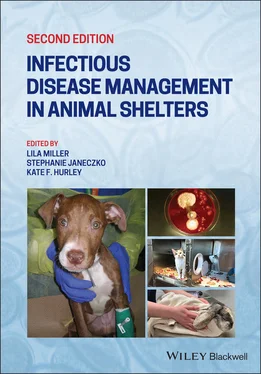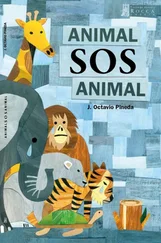The second example above highlights the impact of a growing body of shelter‐specific research that extends well beyond the traditional arsenal of infectious disease management tools. The development of the portal was based on the finding that the risk for feline URI was dramatically lessened by the provision of >8 ft 2floor space in cage housing during the first week of care (Wagner et al. 2018). Another study documented improved immunity and decreased feline URI risk associated with consistent, gentle human interaction with cats (Gourkow and Phillips 2015). The importance of such non‐traditional approaches to disease management is reflected in Chapter 2on Wellness and elsewhere throughout this text.
1.2 The Growth of Shelter Medicine
While scientific advances have been significant, one of the most dramatic developments regarding disease control in shelters has been the rapid evolution of the field of shelter medicine itself. The original edition of this book was published within a decade of such milestones as the first formal course in shelter medicine (taught at Cornell University in 1999), the establishment of the first Shelter Medicine residency training program at UC Davis in 2001, and the founding of the Association of Shelter Veterinarians (ASV) in that same year. Many veterinary colleges have since incorporated shelter medicine classes and shelter externship opportunities into their core and elective curricula.
In the decade since then, the rapid expansion of shelter medicine has been a striking development within veterinary medicine as well as within the field of animal sheltering. From a disease control perspective, a major milestone was reached with the publication of the ASV Guidelines for Standards of Care in Animal Shelters in 2010. This document addressed everything from shelter management, policy and record‐keeping; through population management, facility design and sanitation; to the maintenance of physical and behavioral health of animals. The guidelines provide a powerful foundation for any program to maintain shelter animal health because all these elements are interrelated.
In addition to the ASV shelter guidelines, there has been an explosion of resources regarding virtually every aspect of shelter animal care and management. Along with a second edition of the seminal textbook “Shelter Medicine for Veterinarians and Staff,” veterinary guidelines and/or textbooks now exist addressing data collection and interpretation in shelters; animal behavior for shelter veterinarians and staff, forensic medicine; high quality, high volume spay/neuter, and more. Websites maintained by shelter medicine programs at various veterinary colleges (e.g. UC Davis, Cornell, the University of Florida, University of Wisconsin) and organizations such as the American Society for the Prevention of Cruelty to Animals (ASPCA) and Maddies' Fund are just a few of the resources that provide useful and practical information for shelter medicine professionals.
The development of shelter medicine as a veterinary specialty has accompanied this proliferation of resources and research. The American Board of Veterinary Specialties conferred provisional recognition of shelter medicine as a specialty within the American Board of Veterinary Practitioners (ABVP) in 2014, and the first diplomates were certified the following year. As more veterinarians seek and attain board certification in shelter medicine, the pool of research and expert consultants to support successful disease‐control programs in shelters will continue to grow.
1.2.1 Continued Advances in Animal Shelter Management
Advances in shelter medicine over the last decade have paralleled and supported the rapid evolution of animal‐shelter management and community policy concerning abused, homeless and free‐roaming dogs and cats. These changes, in turn, have resulted in substantially improved outcomes for shelter animals in many regions. A national database, Shelter Animals Count, ( www.shelteranimalscount.org) has been developed to document these trends within the United States. Improvements to cat outcomes have been particularly striking. In 2018, the Million Cat Challenge ( www.millioncatchallenge.org) announced that over 1,300 member shelters increased life‐saving success compared to each shelter's baseline by over 1.1 million cats in the four years from 2014 to 2018.
With improved outcomes, a positive cycle has been created that further supports successful programs to control disease. Though the belief that euthanasia should be reserved for dangerous or suffering animals is a widely shared value, historically, the number of live outcomes has failed to keep pace with the rate at which healthy animals were admitted to many shelters. This created a painful dilemma: either euthanize healthy animals to create space or permit crowding and allow the resultant disease to take its toll. Non‐lethal methods to balance shelter intakes with live outcomes are therefore a potent tool to maintain shelter animal health and welfare.
The practice of “Return to Field” (RTF) (also sometimes called Shelter/Neuter/Return), widely implemented in US shelters over the last decade, provides an example of this phenomenon. (Spehar and Wolf 2019). These programs involve sterilizing, vaccinating and returning cats to the location of origin, and are differentiated from traditional Trap/Neuter/Return (TNR) programs in that they target cats admitted to the shelter as part of normal animal control services, versus specifically captured with the intent to have the cat sterilized. Analysis of one of the first large‐scale RTF programs demonstrated not only a reduction in euthanasia of over 75%, but also a 99% decrease in the number of cats euthanized for URI. With an additional outlet for healthy cats other than adoption, shelter managers are far less likely to face a choice between crowding or euthanasia – and the impact on feline health can be dramatic.
1.3 Capacity for Care: Blending Shelter Medicine and Management
The foregoing examples demonstrate the synergy that occurs when shelter health and shelter management practices work in support of each other. The most effective infectious disease control program will address the overall functioning of the shelter as a system, balancing animal intake with the organization's ability to provide appropriate care and find suitable outcomes. The success of this approach has been demonstrated in a shelter management model known as “Capacity for Care,” which has been linked to decreased disease and euthanasia and increased live release rates (Karsten et al. 2017). Though piloted with an emphasis on cats, this model applies equally to dogs and involves optimizing the number of animals housed at any one time; actively managing the LOS of animals in the shelter; providing housing for each animal that meets or exceeds the ASV Guidelines for Standards of Care in Animal Shelters and using methods such as scheduled admission and removing barriers to adoption to maintain the population within the organization's humane capacity without resorting to increased euthanasia (CFHS 2016).
Whether used under the formal umbrella of the Capacity for Care management model or otherwise, these practices, when combined, represent an integrated approach that powerfully supports animal health and limits environmental disease transmission. Under these conditions, it is realistic to expect the spread of serious infectious disease to be a relatively rare event. The shelter practitioner can then turn their attention to the chapters within this text that focus on methods to treat animals that enter the shelter already infected, or to improve the health of animals in the community.
Conversely, when housing is poor, LOS prolonged, or animal care is otherwise compromised because shelter capacity is exceeded, even the best vaccination, segregation and sanitation practices will be insufficient. In the face of repeated outbreaks or high levels of endemic disease, the reader is encouraged to revisit this chapter and access other resources – including the numerous guidelines, texts, and consulting services now available – to bring the shelter population into greater balance with the organization's ability to provide care.
Читать дальше












